An outdoor bonsai tree can be a beautiful addition to your home landscape. It can be a great centerpiece, which can catch the attention and admiration of your guests.
If you want to cultivate one, you must know which bonsai tree species to get and what proper care and maintenance to follow. With that said…
Read on to learn:
- What an outdoor miniature tree is.
- 5 outdoor miniature tree species for beginners.
- How to properly care for and maintain a bonsai tree outdoors.
- What to consider when selecting an outdoor miniature tree species.
- And so much more…
What Is an Outdoor Bonsai Tree?

Outdoor miniature trees are plant species that can withstand or needs to be exposed to all four seasons of the year (two in tropical and subtropical regions) to grow and thrive. Keeping them indoors would only cause them to weaken or die.
Since the condition outdoors changes, adjusting the care and maintenance routine is necessary to fit the tree’s needs.
Selecting an Outdoor Miniature Tree to Cultivate
Although many species can survive in the outdoor environment, some species can only survive in specific climates. Extreme coldness or hotness can be detrimental to the health of specific specimens.
That being said, the first thing that you must consider when selecting a bonsai to cultivate is the climate in your region.
Here’s a quick guide on what tree species to get based on the region/climate:
- Temperate climate: Mediterranean or subtropical species.
- Maritime climate with moist summer: species that don’t like too much moisture.
- Tropical climate: species that can withstand high temperatures and direct sunlight.
- Regions with cool winters: species that require a period of winter dormancy. (Example: Japanese maple)
- Regions with hot summers and cold winters: species that need protection from frost and intensive heat. (Example: Chinese elm, Japanese black pine)
If you find choosing a suitable bonsai species quite difficult, get one native to your region. Such species are most like to thrive for years as they are well-adapted to the local climate.
5 Best Outdoor Miniature Trees for Beginners
Growing tiny trees outdoors can be fun and exciting. However, for it to thrive, you must select a hardy species that can withstand the changing environment outside your home.
To give you some options, here are some of the best and most popular bonsai tree species that can thrive outdoors:
1. Juniper bonsai tree
Junipers are one of the highly-recommended tree species for beginners due to being low maintenance. It’s drought-tolerant and requires little winter protection, plus it’s also very forgiving to heavy pruning and bending.
Aesthetic-wise, a juniper has an elegant look thanks to its jins and sharis.
2. Chinese elm bonsai tree
Another beginner-friendly bonsai species is the Chinese elm, which can be planted indoors and outdoors.
Apart from its robustness, Chinese elm is adored by many bonsai growers due to its small, glossy leaves and samaras. A samara is a tiny fruit that appears in clusters during autumn.
3. Azalea bonsai tree
Are you into flowering specimens? Then, get an azalea bonsai tree with eye-catching and colorful blossoms that can alleviate your garden’s aesthetic.
More than that, it’s hardy and susceptible to pests, which is advantageous to every beginner bonsai enthusiast.
4. Japanese maple bonsai tree
Japanese maples are a favorite of those who enjoy colorful fall colors. The leaves of these species turn yellow, orange, red, and purple, depending on the species, during the autumn season.
Apart from that, it’s very sturdy and frost-hardy, which makes it easier to maintain year-round compared to other bonsai species.
5. Japanese black pine bonsai tree
Japanese black pines develop a great shape once trained. It’s known for its thick trunk and extreme taper, which helps bonsai growers easily achieve a classic-looking bonsai.
Pines like this have strong, hard needles, plus they produce two flushes of growth a year, making heavy pruning not a problem.
A Complete Outdoor Bonsai Tree Care Guide
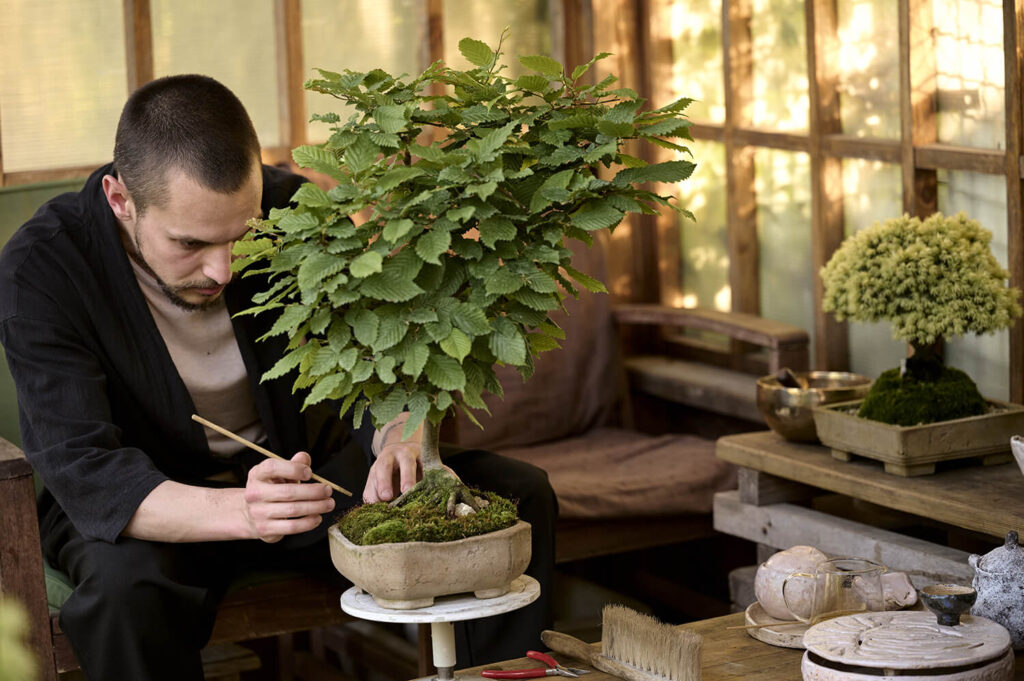
Most trees can thrive outdoors if given the proper care and maintenance. However, since bonsai trees are planted in small pots, a beginner enthusiast like you may find it more challenging than growing a normal house plant.
To help you out, here’s an easy-to-follow guide on how you can take care of the miniature versions of your favorite trees outdoors:
I. Positioning
The two things you must prioritize when choosing a location for your outdoor miniature tree are light and air humidity.
Light
The most important thing you must consider is the amount of full sunlight an area receives.
Most species, such as conifers, must be exposed to full sun for a few hours a day to thrive. However, some species would deteriorate when exposed to too much sun.
In general, you should place your bonsai in a spot that receives morning sun and afternoon shade. That way, your tree can benefit from the sun in the morning and prevent suffering from leaf burn in the afternoon. If you don’t have an area in your garden with afternoon shade, use shade nets to protect your outdoor miniature trees from harmful direct sunlight.
Suppose your bonsai garden doesn’t receive much sunlight or is very shady (located in the north or east); here are some things you can do:
- Shorten tall hedges near the location of your bonsai
- Chop down the branches of some large trees or plants
Air humidity
High humidity helps encourage healthy and thriving growth. Hence, you must choose a location with fresh air and good air circulation.
Here are some ways to ensure that there’s high humidity around your outdoor miniature tree:
- Move it to an open garden with grass.
- Position it near shrubs, hedges, and short trees that don’t block the sunlight.
- Avoid placing it close to paved walkways and cement walls, especially on hot days.
Note: In regions with constant winds, the humidity decreases, so you may need to water your tree more frequently.
In general, positioning your bonsai tree in an open garden, patio, balcony, or terrace that receives sufficient light and has high humidity is always a good idea.
For the best view, display your outdoor miniature trees at eye level. Use 3 to 4 ft. high display stands that complements the pot and features of your trees.
II. Watering
The water needs of a tree change depending on its size, health condition, and the local climate. With that said, you must never water on routine and provide sufficient watering on your trees individually as much as possible.
Generally, you should water your outdoor bonsai plant once the soil dries slightly but not completely dry. Depending on the climate, that can be a few times a day or a week.
Tip: Use a moisture meter to monitor the soil’s moisture level as accurately as possible. Then, use it to determine when to water your bonsai.
When watering, continue pouring until the water runs out of the pot’s drainage holes. You should also use a watering can or a hose with a rosette head that mimics soft raindrops to avoid disturbing the soil surface and damaging new growth.
If you live in a region with hot summers or high temperatures, here are some ways you can retain moisture on your bonsai:
- Use a humidity tray.
- Mist your tree a few times a day.
- Cover its soil surface with moss or plastic.
- Wet the surrounding paved walkways and walls.
- Use water-retaining soil substrates like pine bark.
III. Fertilizing
Fertilize your outdoor miniature trees every two weeks during the growing season (between early spring and mid-summer).
To promote healthy and strong new growth, place slow-release pellet fertilizers on the soil surface of your bonsai. That way, your tree will absorb nutrients every time you water it. You can also practice foliar feeding using a liquid concentrate once a month for an extra boost.
Note: Fertilizing isn’t necessary during the winter season. However, some species, particularly coniferous trees, benefits from it.
IV. Repotting
Once the roots fill the container, take it as a sign to repot your outdoor miniature tree. Although some bonsai trees can be repotted year-round, it’s best to do it in the early spring, when many species are still dormant.
Depending on the species, here’s how often your should repot:
- Deciduous: 2 to 3 years
- Evergreens: 4 to 5 years
You can also prune ¼ of the root mass during repotting to control the root growth, helping the tree remain miniature.
More importantly, use fresh well-draining soil to avoid underwatering and overwatering. Doing this also helps eliminate potential pests and fungal diseases clinging to your old bonsai soil.
V. Winter Care
Depending on the species, you may need to overwinter or protect your tree from frost and strong winds during the winter season.
Note: Winter care is only necessary for regions with a cooler climate.
Here’s a short winter care guide based on the species:
- Tropical trees in a temperate climate: Needs complete winter protection.
- Temperate trees in a temperate climate: Many can be kept outdoors, and some require winter protection.
- Subtropical trees in a temperate climate: Most need complete winter protection, but others can tolerate lower temperate than standard room temperature.
If you need to keep your bonsai protected in the winter, here are several ways you can do it:
- Move it to an unheated shed or garage.
- Place it tree in a greenhouse or cold frame.
- Bury it to the ground without a pot up to its first branch.
You can also watch this video to learn how to overwinter an outdoor miniature tree:
Conclusion
Bonsai art is an enjoyable and rewarding hobby.
Just choose a suitable species and continue to provide proper care and maintenance for many years, and you’ll grow an outdoor bonsai tree with a classic and priceless beauty. Those alone can help you create a masterpiece you can pass on from generation to generation.


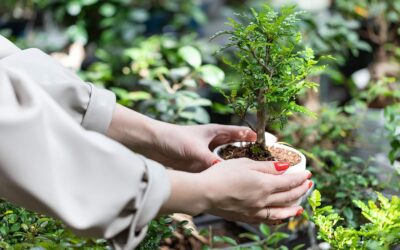
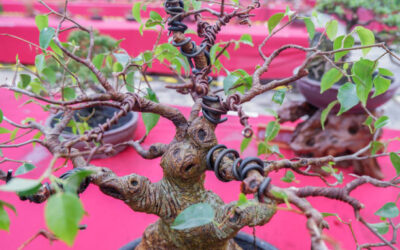
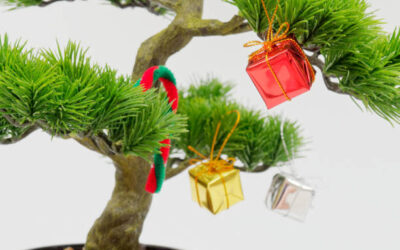
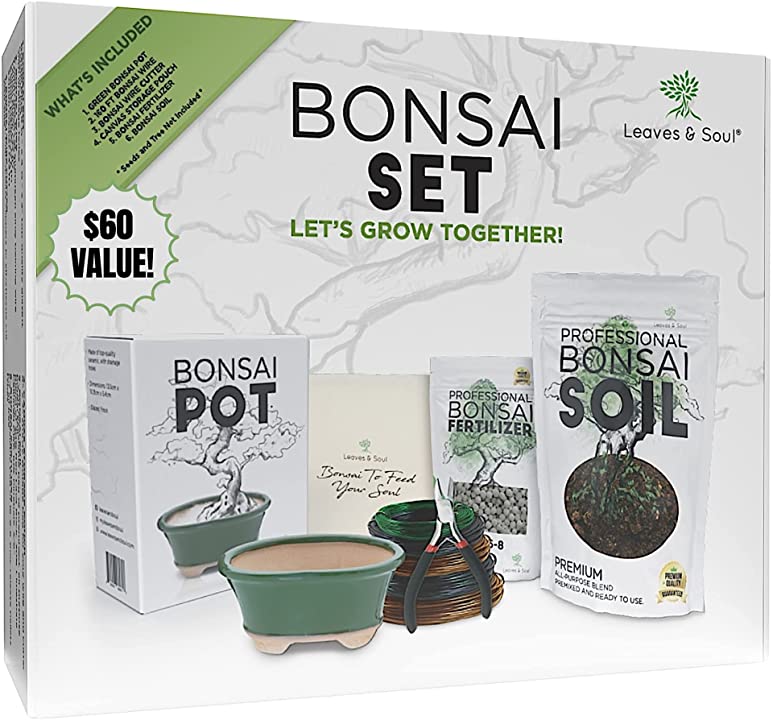
0 Comments